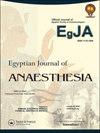Longitudinal analysis of electrolyte prolife in intensive care COVID-19 patients
IF 0.5
Q3 ANESTHESIOLOGY
引用次数: 0
Abstract
ABSTRACT Introduction According to a substantial body of research, electrolyte abnormalities are a common manifestation in coronavirus disease 2019 (COVID-19) patients and are associated with adverse outcomes. This study aimed to investigate electrolyte imbalances in COVID-19 patients and assess their relation to mortality. Methods Adult COVID-19 patients hospitalized in the Security Forces Hospital in Saudi Arabia from June 8th till August 18th, 2020 were enrolled in this retrospective observational study. We examined baseline characteristics, comorbidities, acute organ injuries, medications, and electrolyte levels including sodium, potassium, chloride, calcium, bicarbonate, phosphate, and magnesium on ICU admission, as well as every following day of ICU stay, until death or discharge. Patients were stratified according to survival, and differences in variables between groups were compared using Mann-Whitney’s U test or Fisher’s exact test. Longitudinal electrolyte profiles were modeled using random intercept linear regression models. Results A total of 60 COVID-19 patients were enrolled. Compared to survivors, non-survivors had significantly higher sodium and phosphate on admission and death, higher potassium and magnesium at death, and significantly lower calcium at death. Abnormalities in admission levels of chloride and bicarbonate were also more frequently observed in non-survivors. Furthermore, in the deceased group, we observed a daily increase in potassium and phosphate levels, and a daily decrease in sodium and chloride. Finally, calcium increased in non-survivors over time, however, not as significantly as in the survivor group. Conclusion Admission levels of electrolytes and changes over the course of ICU stay appear to be associated with mortality in COVID-19 patients.重症监护COVID-19患者电解质增殖的纵向分析
本文章由计算机程序翻译,如有差异,请以英文原文为准。
求助全文
约1分钟内获得全文
求助全文
来源期刊

Egyptian Journal of Anaesthesia
Medicine-Anesthesiology and Pain Medicine
CiteScore
0.90
自引率
0.00%
发文量
78
 求助内容:
求助内容: 应助结果提醒方式:
应助结果提醒方式:


